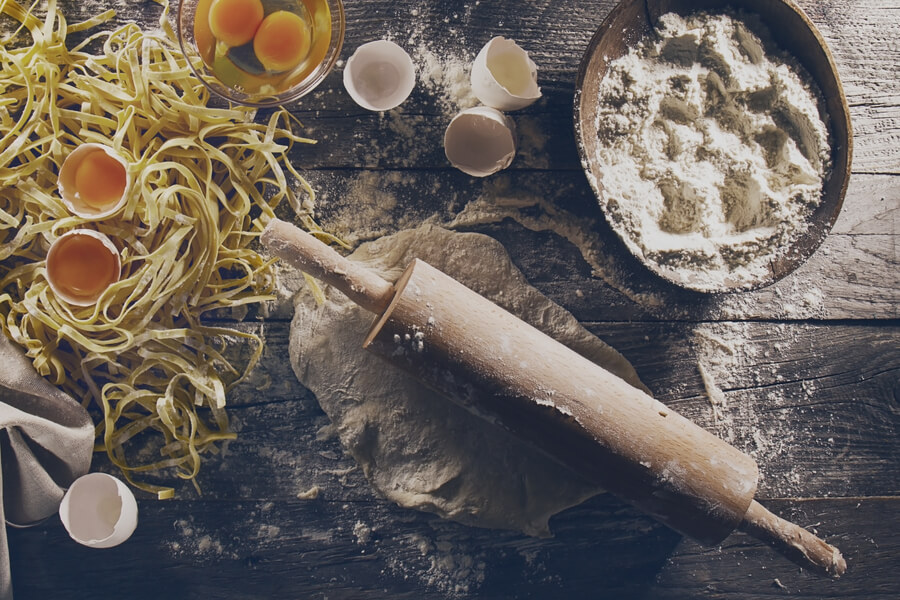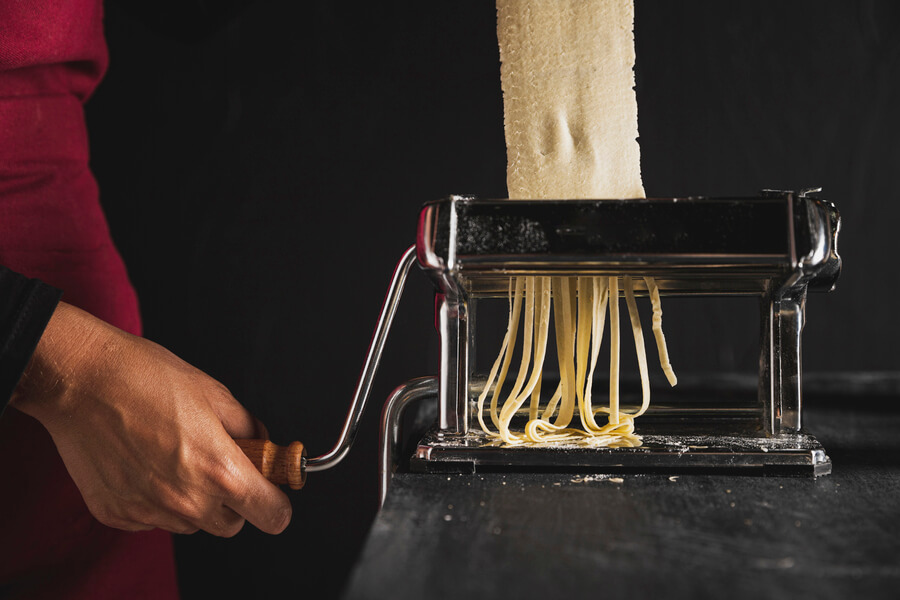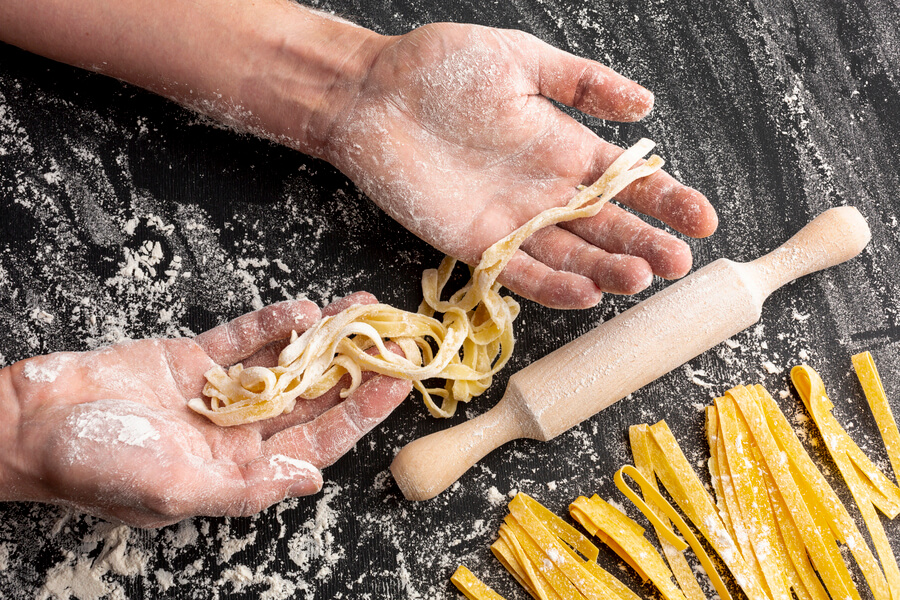Making pasta can be an easy task if done in the correct procedure. The proper egg, flour, and water ratio makes the perfect pasta.

Unfortunately, it is not uncommon for the dough to get crumbly. When this happens, it becomes daunting to create desired pasta shapes. So, how can you mitigate this? Let’s find out.
What Causes Pasta Dough To Get Crumbly?
Here are some reasons why your pasta dough breaks into small fragments.
Using Too Much Flour
The most popular reason why the dough crumbly is using too much flour. With too much flour, the gluten will not form properly, causing it to become dry. If you are following a recipe, use less than required flour. You can then add more flour to achieve the ideal texture.
Over kneading
Another reason for the crumbly dough is over-kneading. As you’d expect, over-kneading a dough can be a daunting task. But with the right ingredient balance, you can knead the dough with minimal issues.
Likewise, you want to avoid over-knead it since the gluten will not form, leading to a not-so-good pasta dough.
For best results, knead for an extended period until the ingredients are combined. It will help you create a smooth texture. Knead the dough until any visible specks of flour are no more. To assess whether you are over- or under-kneading, you can use your hands to feel the texture.
While a kneading machine can be a time saver, it often leads to over-kneading, especially if you pay little attention. To mitigate this, eel the dough’s texture after a few minutes of kneading.
Exposing The Dough To Dry Air
Like any other dough, you should give the pasta dough ample time to rise. Generally, a dough requires at least 30 minutes to achieve the right texture. Unfortunately, the storage area might be dry. And without ample humidity, the dough might dry out, breaking into small pieces.
Remedies For Crumbly Pasta Dough
What can you do if your pasta dough becomes crumbly? Let’s find out.
Use More Water
If the dough is breaking into small pieces when kneading or after resting, you can add more water to soften it. If the dough is not overly dry, you can wet your hands and knead the dough to the desired texture.
Alternatively, you can use a pasta machine to form a sheet and sprinkle water on both sides. Let it sit for a few minutes before kneading again.
If the dough is extremely dry, add a spoonful of water and knead it again. Knead until you achieve the desired texture.
And if you add too much water, you can add extra flour to achieve a balanced texture. Finally, let it rest for 30 minutes before feeding the dough to the pasta machine.
Let It Rest
The dough might still seem dry after resting for 30 minutes. If this is the case, let it rest longer while ensuring a moist environment. Otherwise, it will become dryer.
You can wet a kitchen towel and place it over the dough. While not an ideal remedy, it is better than adding water to the dough and kneading again.
Add Oil
If adding water and flour does not solve the problem, you can add a little olive oil. It will make the dough moist and soft, especially if you are making it in a dry environment. Unlike water, oil does not evaporate, ensuring the dough stays moist for an extended period.
However, not all pasta recipes and flour are compatible with adding more oil. So, ascertain that adding extra oil will maintain the pasta’s shape and flavor.
Use The Right Flour
You can make pasta using three types of flour: all-purpose, semola, and 00 flour. These flours contain the right amount of gluten that allows proper plasticity and elasticity.
Most pasta makers use all-purpose flour since it is readily available and can make different types of pasta. Besides, it contains lower protein content, meaning the dough will be softer and have a delicate texture. So, if you want to make pappardelle, fettuccine, or ravioli, all-purpose flour is your best choice.
Semola or macaroni wheat is ideal for making thick and rugged pasta. While it has more plasticity than the all-purpose floor, it is less elastic, meaning the pasta won’t lose its shape while being cooked. It is the perfect choice for making macaroni and shapes like cavatelli and orecchiette.
Some pasta recipes will call for more specific flours, such as 00. Unlike semola, 00 flour has a finer texture and is more elastic. Thanks to its powdery consistency, it is an ideal option for making ravioli and tagliatelle pasta.
Switch To A Pasta Machine

While experienced pasta can make quality pasta dough with their hands, novice pasta makers can find it daunting. This leads to a crumbly dough with an inconsistent texture. To mitigate this, you can use an electric pasta machine.
A pasta machine comes with many benefits, among them creating pasta dough with the right texture. Some electric pasta machines have a kneading component that ensures a balanced mixing of ingredients. This produces a dough with the right texture and consistency.
How To Make Fresh Pasta
Make The Right Dough
To make fresh pasta, you need the right dough. Ask any pasta, and they’ll tell you the secret lies in creating the perfect dough. With the perfect texture, it will be easier to feed it to a pasta machine so you can get your thin strips.
Kneading is at the core of dough making. It would be best to work on the dough until it is smooth and elastic. And you can tell this by how it feels.
Cut The Dough Into Smaller Pieces
While most pasta makers will let the dough settle as a whole, it is more prudent to separate it into more petite balls. It will help you achieve consistent moisture content.
All you need to do is cover them with a wet kitchen towel. Furthermore, rolling the balls into oval shapes and feeding them into the pasta machine will be easier.
Use Simple Shapes

As a beginner, focus on something other than making complex pasta shapes, which will lead to failure. Start slow and gradually work on your pasta-making skills. Some of the basic shapes you can start with include the following:
- Fettuccine
- Paradelle
- Gnocchi
- Lasagna
As you improve your skills, you can transition to complex shapes like tortellini, cavatappi, and ravioli.
Final Thoughts
By using the proper flour-to-water ratio, you can prevent your pasta dough from getting crumbly. You can also use olive oil if the dough is not extremely dry. You should also knead for up to 10 minutes. Going beyond this will destroy the gluten protein bonds.
Remember to cover the dough with a wet towel to prevent it from getting dry. Separate it into smaller balls. It will help you create oval shapes that are easier to feed to a pasta-making machine.
